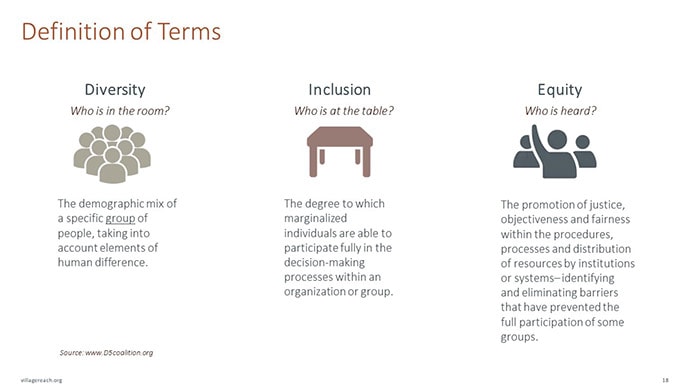How a global non-profit revamped its communications to reflect its core values
By Andie Long
Director of Communications & Marketing
Global Washington
A year and a half ago, Jodi-Ann Burey, a health systems manager for VillageReach, sent an uncomfortable email. The organization had just appointed a new president, and his third day on the job, Burey figured the time was ripe to shake things up.
“Hey, I just wanted to talk with you about the lack of racial and cultural diversity in our headquarters,” Burey says she wrote to him. Wondering for a moment if she had just torpedoed her career, Burey was relieved to receive an email response right back, saying, “Let’s talk about it.”
After having a series of intense and emotional conversations with senior leaders at VillageReach about how the way they communicated as an organization mattered, Burey was tapped to lead a new internal working group. They called themselves the Diversity & Inclusion Group (DIG), and they took on the role of “assessing, creating, and sustaining diverse, inclusive, and equitable organizational policies and practices,” within VillageReach.
Five members sit on core DIG team: VillageReach’s president, an HR representative, and three rotating members. Each of the members support and/or lead one of the four working groups: External Communications, Internal Communications, Personal Learning & Development, and Human Resources.
They asked themselves questions such as,
- Does the organization’s brand and messaging reflect its core values?
- Does it promote a culture of inclusion and diversity that can be felt by the 180+ VillageReach staff spread across all eight countries where they worked?
- Do staff feel like they have the tools to operationalize this approach to promoting diversity, equity and inclusion in their own work?
- When it comes to the organization’s hiring practices, how can they attract, hire and retain a more diverse workforce?
Making diversity, equity, and inclusion a priority at any organization may be considered “the right thing to do,” but according to Burey, there are also a variety of other benefits, from attracting and retaining talented employees, to improving and strengthening an organization’s brand.

While the development industry has struggled to divorce itself from a historical fundraising and communications style that some have referred to as Poverty Porn, it’s not always easy to identify what’s appropriate, and what’s not, where one person’s interpretation and reaction to a message or image might be radically different than someone else’s. To take some of the personal subjectivity out of it, DIG members at VillageReach decided they first had to define the terms.

Pulling from the D5 Coalition, a group dedicated to advancing philanthropy’s diversity, equity, and inclusion, DIG found that the three terms – Diversity, Inclusion, and Equity – boiled down to three questions: Who is in the room? Who is at the table? And who is heard?
At an event hosted by Global Washington on October 25, Burey took the audience through examples of the importance of language and photos in storytelling, and she shared their internal evaluation criteria to ensure communications materials aligned with VillageReach’s guiding principles.
After Burey’s presentation, audience members were encouraged to write one thing they planned to do with the knowledge they’d gained. Responses ranged from personal to organizational next steps.
“Be vulnerable”
“Implement anonymous mechanism for feedback.”
“Figure out how to talk about my whiteness when I am talking about our work in diversity, equity and inclusion.”
“Being an active advocate and ally at work – not being afraid to speak up and/or call things out.”
“Consider how to interview job candidates differently.”
“Make more of an effort to keep ‘otherness’ out of our communications.”
“Observe power-related language in external communications.”
Although VillageReach acknowledges its journey is just beginning, it has made some of its DIG resources available for download.
Has your organization wrestled with this topic? If you’re a current member of Global Washington, send us an email at comms@globalwa.org and let us know how you’ve worked to ensure your communications reflect DEI values. Have you conducted an audit of your existing communications materials? What other resources would you find helpful?